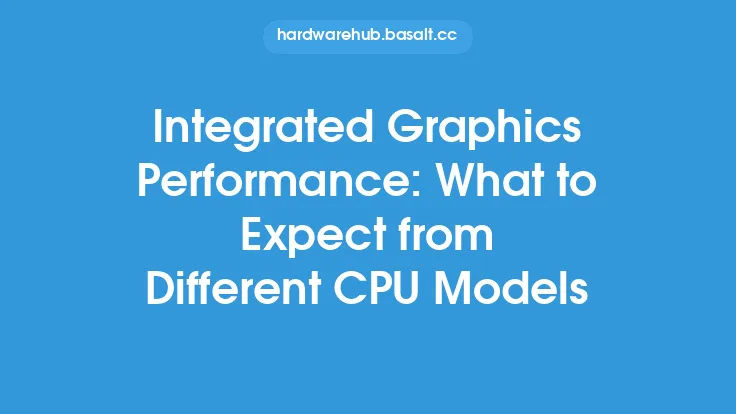When it comes to choosing a graphics processing unit (GPU), one of the most important factors to consider is the price range. Different price ranges offer varying levels of performance, and understanding what to expect from each range can help you make an informed decision. In this article, we'll delve into the world of GPU performance and explore what you can expect from different price ranges.
Introduction to GPU Price Ranges
The GPU market is divided into several price ranges, each catering to specific needs and budgets. The main price ranges are entry-level, mid-range, high-end, and enthusiast-level. Entry-level GPUs are designed for basic tasks such as web browsing, office work, and casual gaming, while mid-range GPUs offer better performance for more demanding tasks like gaming and video editing. High-end GPUs are designed for serious gamers and professionals who require top-notch performance, and enthusiast-level GPUs are for those who want the absolute best performance, often at a premium price.
Entry-Level GPU Performance
Entry-level GPUs are typically priced between $100 and $300 and offer basic performance for general computing tasks. These GPUs usually have lower clock speeds, fewer CUDA cores or stream processors, and less video memory. They are suitable for playing older games at lower resolutions and settings, as well as for general computing tasks like web browsing and office work. Some examples of entry-level GPUs include the NVIDIA GeForce GTX 1650 and the AMD Radeon RX 5500 XT. While they may not offer the best performance, entry-level GPUs are a great option for those on a tight budget or who only need a GPU for basic tasks.
Mid-Range GPU Performance
Mid-range GPUs are priced between $300 and $600 and offer significantly better performance than entry-level GPUs. They usually have higher clock speeds, more CUDA cores or stream processors, and more video memory. Mid-range GPUs are suitable for playing modern games at medium to high settings, as well as for tasks like video editing and graphics design. Some examples of mid-range GPUs include the NVIDIA GeForce RTX 3060 and the AMD Radeon RX 6700 XT. Mid-range GPUs offer a great balance between performance and price, making them a popular choice for many users.
High-End GPU Performance
High-end GPUs are priced between $600 and $1,200 and offer top-notch performance for demanding tasks like 4K gaming, video editing, and graphics design. They usually have high clock speeds, many CUDA cores or stream processors, and large amounts of video memory. High-end GPUs are suitable for playing modern games at high settings, as well as for professional applications like video editing and 3D modeling. Some examples of high-end GPUs include the NVIDIA GeForce RTX 3080 and the AMD Radeon RX 6800 XT. High-end GPUs offer the best performance available, but often come with a premium price tag.
Enthusiast-Level GPU Performance
Enthusiast-level GPUs are priced above $1,200 and offer the absolute best performance available. They usually have extremely high clock speeds, many CUDA cores or stream processors, and large amounts of video memory. Enthusiast-level GPUs are suitable for extreme gaming, professional applications, and other demanding tasks. Some examples of enthusiast-level GPUs include the NVIDIA GeForce RTX 3090 and the AMD Radeon RX 6900 XT. Enthusiast-level GPUs are for those who want the absolute best performance, often at a significant cost.
GPU Architecture and Performance
GPU architecture plays a significant role in determining performance. Different architectures offer varying levels of performance, power consumption, and features. For example, NVIDIA's Ampere architecture offers better performance and power efficiency than their previous Turing architecture. Similarly, AMD's RDNA 2 architecture offers better performance and power efficiency than their previous GCN architecture. Understanding the different GPU architectures and their features can help you make an informed decision when choosing a GPU.
GPU Memory and Performance
GPU memory, also known as video random access memory (VRAM), plays a crucial role in determining performance. More VRAM allows for higher resolutions, more complex graphics, and better performance. However, more VRAM also increases the cost of the GPU. Different types of VRAM, such as GDDR6 and HBM2, offer varying levels of performance and power consumption. Understanding the different types of VRAM and their features can help you choose a GPU that meets your needs.
Conclusion
In conclusion, GPU performance varies significantly across different price ranges. Understanding what to expect from each price range can help you make an informed decision when choosing a GPU. From entry-level GPUs for basic tasks to enthusiast-level GPUs for extreme gaming and professional applications, there is a GPU available for every need and budget. By considering factors like GPU architecture, memory, and price, you can choose a GPU that meets your needs and provides the best performance for your budget. Whether you're a gamer, professional, or general user, there is a GPU available that can provide the performance you need to get the job done.





